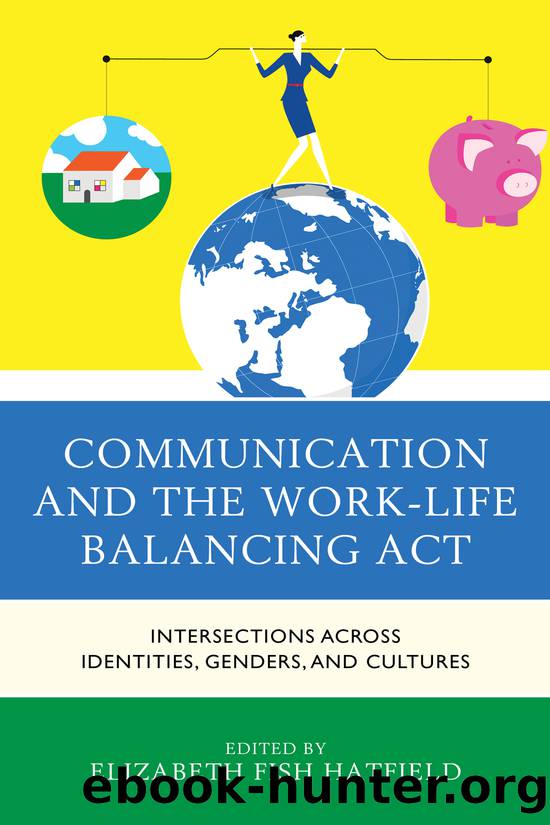Communication and the Work-Life Balancing Act by unknow

Author:unknow
Language: eng
Format: epub
Publisher: Lexington Books/Fortress Academic
Chapter 7
Itâs About Priorities
Adaptation Strategies of Dual-Military Couples
David G. Smith
Military service can influence life-course trajectories based on the timing of role transitions and the demands placed on service members and their families (Gade, 1991). Dual-military couples provide a special case of dual-career couples for this study, focusing on how these couplesâ roles, role transitions, and timing of roles are shaped by the institutional and cultural structure of the military organization. Like other professions and occupations with a careerist focus (e.g. STEM), the military has created an implicit hierarchy of family types that gives privilege and power to those with a male breadwinner. While other occupations are better suited to the âscaling backâ of careers, contract work or entrepreneurial opportunities as evidenced by recent trends of âmompreneurship,â the militaryâs âup or outâ promotion system is strictly tied to career paths by federal law. Analyzing critical military work transitions such as joining the military, military occupational specialty, job assignments, and location selection and how they are interrelated to family role transitions can provide insight into how these couplesâ decision-making communications are shaped by surrounding institutional and cultural structures (Gade, 1991; Kelty & Segal, 2013).
Societal norms for work-family relationships have continued to shift over the past five decades and provide the context for understanding work-family prioritization strategies. Where previously career priority was given to the male spouse, evidence suggests that we can no longer make this assumption (Pixley, 2008; Pixley & Moen, 2003). Indeed, recent Pew research shows that 40 percent of primary family breadwinners with children are women (Wang, Parker & Taylor, 2013). In addition to family types changing, there has been a downward trend in fertility and an increase in the median age at first childbirth which is of interest when considering the intersection of work and family roles (Altucher & Williams, 2003; Wang et al., 2013). While womenâs work careers often appear disorderly and interrupted as compared to menâs work careers because of children and childcare, in todayâs society more women are returning to work after childbirth (Moen, 2003). For dual-career couples, the demands of maintaining two careers and a family may impact the work and family goals, leading to new career pathways (Moen & Sweet, 2002). Further, as transformations in the labor force, economy, and the structure of work careers are encountered, new relational contexts for work careers can be expected (Moen & Han, 2001).
In particular, changes to the structure of work can be understood through the nature of the relationship between employee and employer that has changed dramatically over the last 50 years due to globalization, the service industry economy, and technological advances (Moen & Roehling, 2005). The old standard of continuous employment, job security, and an occupational career path has been replaced with restructuring, downsizing, mergers and layoffs (Moen & Roehling, 2005). This change in the work relationship, coupled with increased longevity and decreased fertility, has led to changes in the traditional lockstep career model: education-employment-retirement (Moen & Roehling, 2005). Where Social Security and retirement pensions led
Download
This site does not store any files on its server. We only index and link to content provided by other sites. Please contact the content providers to delete copyright contents if any and email us, we'll remove relevant links or contents immediately.
Cecilia; Or, Memoirs of an Heiress — Volume 1 by Fanny Burney(32434)
Cecilia; Or, Memoirs of an Heiress — Volume 2 by Fanny Burney(31868)
Cecilia; Or, Memoirs of an Heiress — Volume 3 by Fanny Burney(31852)
The Lost Art of Listening by Michael P. Nichols(7403)
Asking the Right Questions: A Guide to Critical Thinking by M. Neil Browne & Stuart M. Keeley(5631)
We Need to Talk by Celeste Headlee(5542)
On Writing A Memoir of the Craft by Stephen King(4863)
Dialogue by Robert McKee(4321)
Pre-Suasion: A Revolutionary Way to Influence and Persuade by Robert Cialdini(4144)
I Have Something to Say: Mastering the Art of Public Speaking in an Age of Disconnection by John Bowe(3839)
Elements of Style 2017 by Richard De A'Morelli(3306)
The Book of Human Emotions by Tiffany Watt Smith(3237)
Fluent Forever: How to Learn Any Language Fast and Never Forget It by Gabriel Wyner(3025)
Name Book, The: Over 10,000 Names--Their Meanings, Origins, and Spiritual Significance by Astoria Dorothy(2938)
Good Humor, Bad Taste: A Sociology of the Joke by Kuipers Giselinde(2903)
Why I Write by George Orwell(2874)
The Art Of Deception by Kevin Mitnick(2735)
The Grammaring Guide to English Grammar with Exercises by Péter Simon(2706)
Ancient Worlds by Michael Scott(2622)
